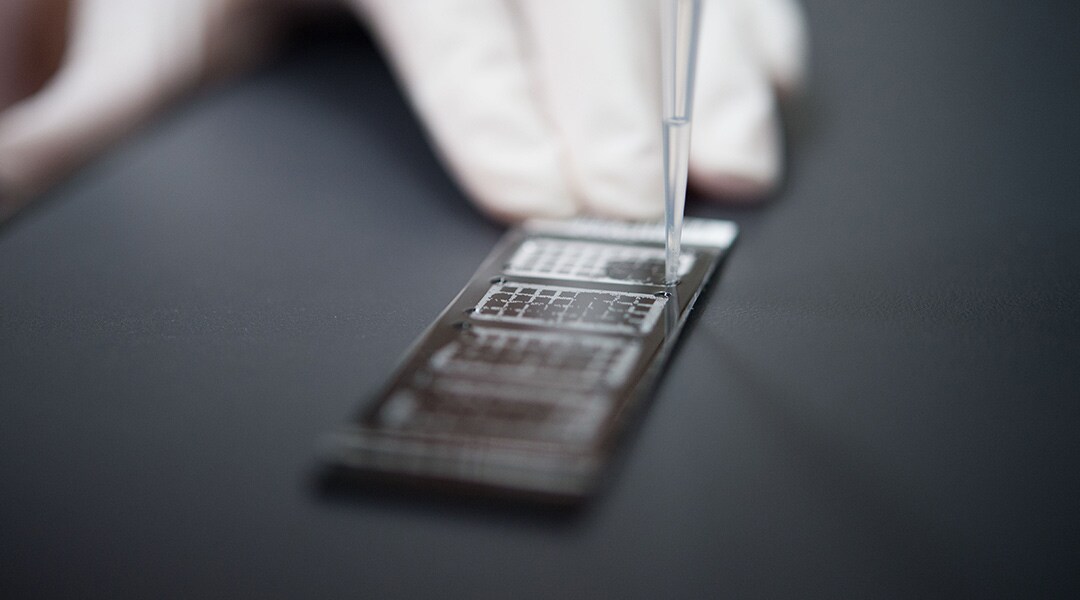#09
Synthetic innovation helps translate nature’s greatest narrative: our genes
Our genes are the blueprints of life – and advanced technology is enabling experts to analyze them in dynamic new ways. The result: earlier detection of diseases and a healthier outlook for future generations.

The life sciences are undergoing an astonishing transformation. Stem-cell research will allow us to replace damaged organs with healthy ones. Gene therapy is bringing new treatments for cancer patients. And personalized medicine promises to neutralize future disease threats.
On this adventure, a powerful tool is enabling scientific breakthroughs that will redefine the limits of human life.
DNA chips, known formally as microarrays, allow researchers to test for mutations and other factors by identifying which genes are expressed – or switched on – in DNA. The analysis yields biomarkers, or indicators – for example, of a specific disease condition – allowing early detection.
“Microarray technology... was an initiating step towards a micro-revolution in the field of molecular biology,” researchers at Oslo University Hospital wrote in a paper published in the journal Nucleic Acids Research. “The technique provides a snapshot of the repertoire of genes expressed by a cell or tissue.”
The perfect match
DNA chips work by placing DNA probes (synthetically created single-strand DNA fragments) on a surface of glass or resin and binding them with an organism’s RNA (the “translator” of gene expression) in a process called hybridization. The sample RNA will fix to the probe only if the two are complementary. That is, if the prongs jutting from each single strand of genetic material are the right match for combining in the familiar twisting-ladder formation of the double helix.
If they do, it means the gene being tested has been “switched on” to perform the instructions carried in the probe DNA. Researchers can, in this way, carry out a variety of critical tasks in molecular biology. For example, they can identify which genes are activated in diseased tissue and compare them with healthy tissue; or spot aberrant gene sequence duplications – a cause of uncontrolled cell proliferation in cancers.
A novel approach
Toray has developed an innovative microarray, the 3D-Gene™ DNA chip, that vastly improves the accuracy of genetic testing compared to conventional microarrays, opening new possibilities in drug discovery – from cancer therapies to Alzheimer’s treatments.
The technology has four unique features that permit hitherto unimaginable precision, enabling detection of even feeble expressions of a particular gene.
– Black resin substrate: microarrays are read by shining a laser on the surface. That causes the genetic fragments, stained with a special dye, to glow fluorescently. Traditional glass substrates contain substances that emit their own fluorescence when exposed to laser light – resulting in “background noise” that might be mistaken for experimental data. The black resin, in contrast, cancels any fluorescence that does not come from the test dyes, enabling a more accurate reading. It also allows researchers to pick up lower levels of gene expression that might have passed unnoticed amid background noise.
– Columnar structure: in contrast to conventional flat glass surfaces, 3D-Gene™ deploys microscopic columns across the substrate. On a flat surface, it’s difficult to set probes in a fixed area and have them keep their shape. The 3D-Gene™’s columns serve as minute “table tops” for the probes, providing a precisely delineated space in which to study results. Because probes are tightly packed together on an elevated base, data acquisition becomes extremely accurate. And it’s the use of resin for the chip, instead of glass, that allows the chip to be molded into its columnar structure.
– Sticky surface: conventional glass substrates require a fixing agent to immobilize the probes, but it’s difficult to apply the agent evenly – resulting in a patchy pattern and inconsistent probe numbers. The 3D-Gene™’s unique resin surface permits uniform attachment of DNA probes, allowing the genetic fragments to adhere firmly to the tops of columns and maximizing the number of probes for optimal data acquisition.
– Microbeads: in conventional chips, the genetic pairing process is slow and somewhat random. 3D-Gene™’s solution is to deploy microbeads that stimulate the reaction of probes and targets. That significantly increases effective pairings. The method involves shaking the microarray after inserting it into a reaction chamber with hybridization solution. This causes the microbeads to swirl around 3D-Gene™’s columns – churning up activity that helps complementary gene fragments to find one another. The beads, however, only work properly in columnar microarrays. On a flat chip, they would crash into the probes and scratch them.
Mapping the future
Toray’s 3D-Gene™ DNA chip has been used to uncover biomarkers for 13 types of cancer, as well as blood markers for dementia including Alzheimer’s disease, with results presented in peer-reviewed journals and at international conferences. “This achievement,” says Toray, “opens the way to early detection of cancer and dementia by low-invasive tests by targeting a small amount of blood.
“Genes are the blueprints of life,” the company says. Innovative tools to interpret these blueprints will play a vital role in tailor-made medical treatments.



